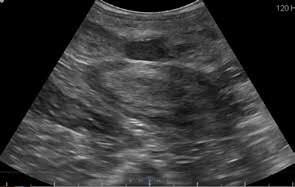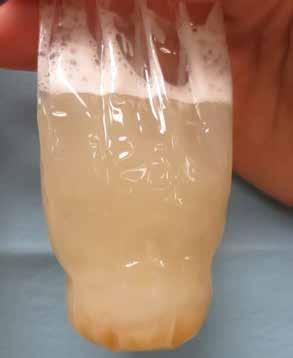
8 minute read
TECHNICIAN UPDATE
Broken or Blocked? The Anejaculatory Stallion
By Katrina LaCaze, BS
VS, a 24-year-old Quarter Horse stallion, presented to the Equine Theriogenology service at Texas A&M Large Animal Hospital in March 2021 for assessment of anejaculation.
The stallion had been purchased from Canada in October 2020, where he had been a successful breeding stallion with live cover, cooled and frozen semen. The stallion was sold with a semen evaluation from late summer 2020 stating that he had low total sperm numbers but very good motility and morphology. After the stallion was purchased, semen collection was attempted multiple times by the referring veterinarian. An ejaculate was not obtained in these efforts; therefore, the stallion was referred to Texas A&M University for further evaluation.
The owner’s goals for this stallion are to breed approximately 5 mares per year via live cover and freeze semen for later use.
The initial day of semen collection attempts was unsuccessful. The stallion demonstrated normal prebreeding behavior and libido when he entered the breeding shed. He was teased to an ovariectomized mare, and his penis was rinsed with warm water and dried with clean towels. VS readily mounted the phantom and collection was attempted on 4 separate mounts using an 18-inch (first 2 mounts) or 22-inch (last 2 mounts) Missouri model artificial vagina, and a hot wet towel (final mount). The stallion showed normal intromission and thrust into the artificial vagina approximately 15 to 18 times before dismounting without ejaculating.
On the second day of attempted collection, VS was given 1,000 mg of imipramine orally and 50 µg of IV GnRh (Cystorelin) 2 hours prior to semen collection and 50 µg of IV GnRh (Cystorelin) again 1 hour prior to the collection attempt. The stallion was brought into the breeding shed and placed into stocks for ampullary massage via the rectum to loosen any potential blockage. The stallion was then teased to an ovariectomized mare, and his penis rinsed with warm water then dried. 20 IU of oxytocin was given intravenously immediately prior to allowing the stallion to mount. A low volume (~8mL) sample was collected after the stallion was allowed to mount the tease mare twice, with a 22” Missouri model artificial vagina fitted with a hot wet towel. The sample contained approximately 2 billion sperm, at 64% total motility, 46% progressive motility, and 66% viability. This ejaculate had a large amount of debris suggesting this was part of a blockage that prevented the passage of sperm and, therefore, limited his ability to ejaculate completely.
Following the same protocol, ejaculates were collected on the following 2 days. The next sample contained a much higher volume (~107 mL) and lower quality (~5 billion sperm at 23% total motility, 15% progressive motility, and 41% viability), along with multiple clumps and debris in the sample. The next ejaculate had a more moderate volume, containing approximately 3 billion sperm at 42% total motility, 28% progressive motility, and 5% viability. This ejaculate showed a greatly reduced amount of clumping and debris in the semen filter. Several of the ejaculates had inflammatory cells present, but there was no bacterial pathogen associated with those ejaculates. It is likely that the inflammatory cells were a result of the blockage in the excurrent ducts.

Hyperechoic area in the ampulla.

Cyst near the seminal colliculus.
Al l images are courtesy of Katrina LaCaze
Subsequently, 2 more ejaculates were collected from the stallion without the use of imipramine and GnRh. These ejaculates were collected using a 22” Missouri model artificial vagina fitted with a hot wet towel and an ovariectomized mare as a mount. IV oxytocin was given immediately prior to the stallion being allowed to mount the mare. While total sperm number stayed fairly consistent (~5 billion sperm), sperm quality parameters improved with each ejaculate. The stallion had a high percent of morphologically normal sperm in all ejaculates. The final ejaculate was processed with a cushion centrifugation and then divided and frozen in 4 different cryopreservation extenders as part of a test freeze.
An ultrasound examination was performed on the stallion’s testicles and internal genitalia. The stallion’s total testicular volume was 196 cc, which is small for an adult Quarter Horse stallion, but was not surprising considering his age. Based on his testes volume, this stallion’s estimated daily sperm of 3.5-3.9 should be satisfactory to fulfill the owners’ breeding goals. No indication of testicular tumors or other abnormalities were noted. Transrectal ultrasonography of the stallion’s accessory sex glands were also performed. Two cysts were identified: One between the caudal ampulla and the other cranial to the seminal colliculus, where the sperm exit the excurrent ducts and enter the pelvic urethra. In addition, there were hyperechoic structures in this area that were abnormal and suggestive of blockage of the sperm ducts. The associated cyst in this area may have been a cause of the blockage. We were able to unblock these structures during the treatment period and allow sperm passage.
The stallion’s owner and referring veterinarian were advised there was potential for VS to return to being blocked if not managed correctly. It was recommended that the stallion be collected at least once a week, even when it is not the breeding season to assist in maintaining patency of the reproductive tract. The owners were able to breed 3 of their personal mares in 2021, 2 with fresh, cooled semen, and 1 with frozen semen. All 3 mares were checked in foal; 1 lost the pregnancy, but the remaining 2 were due to foal in June 2022.
In late April 2022, the stallion returned to the hospital for a recurrence of failure to ejaculate. On the first collection attempt, VS was teased to an ovariectomized mare, his penis was rinsed with warm water and dried with clean towels, then givenIV oxytocin before mounting the tease mare. A 22-inch Missouri AV was used, fitted with a hot, wet towel. After 3 mounts, two low volume samples were collected. A full ejaculation was not obtained. The samples contained a small number of sperm, with little to no motility. Large, amorphous debris were noted within the semen filter.

Cyst located between the caudal portion of the ampullae.

Thick layer of debris/sediment in an ejaculate.
On the 2nd day, the stallion was put into the stocks and the internal reproductive tract evaluated via ultrasonography. The size of the 2 cystic structures identified in 2021 appeared similar to the previous year, and there were multifocal hyperechoic foci in the body of the ampullae and within the seminal colliculus of the ampullae. The ampullae were vigorously massaged via rectal palpation for 10 minutes. Collection was then attempted using the same methods as the previous day, administering 20 IU oxytocin just prior to mounting the tease mare. After 3 mounts, a low volume sample was obtained. Evaluation of the sample was similar to the previous day.
On the third day, VS was once again treated with 10 minutes of ampullary massage. After teasing and washing the penis, the stallion was given 5 mg butorphanol and IV oxytocin before mounting the tease mare. A 22inch Missouri AV with a wet, hot towel was used for two mounts, then changed to an 18-inch AV for the third mount. A full ejaculate was obtained on the 3rd mount containing 11 billion sperm, at 76% total motility, 45% progressive motility, and 80% viability. The stallion owner chose to freeze the semen, and a total of 5 doses were obtained.
Over the next 5 days, 2 more collections were performed, and the ejaculate obtained utilizing this method: ampullary massage, butorphanol, oxytocin, and an 18-inch AV with a hot, wet towel. A total of 20 breeding doses were frozen for the owner.
When the stallion was taken home, it was stressed once again to the stallion owner and referring veterinarian that VS would require frequent semen collections to prevent another blockage from forming. The referring veterinarian continued frequent, twice-a-week collections through the end of the season and was successful in freezing more doses of semen from the horse. One mare was bred and is currently in foal for 2023.
The two mares due to foal in June 2022 both had healthy fillies. The owner reported that the stallion started becoming sore when mounting the phantom and has now been given a couple months off from collection. MeV
About the Author
Katrina LaCaze, BS, is the Equine Theriogenology Technician Supervisor at the Texas A&M University Large Animal Hospital. Ms. LaCaze completed her Bachelor of Science degree in Animal Science at Texas A&M University in 1997. After graduation, Katrina managed a sport horse breeding farm for 6 years before joining Theriogenology in 2003. Katrina takes great pride in helping teach the new generation of veterinarians while sharing her passion for reproduction with them. She spends her free time gardening, showing rabbits and cheering on her son at baseball games and track meets.







